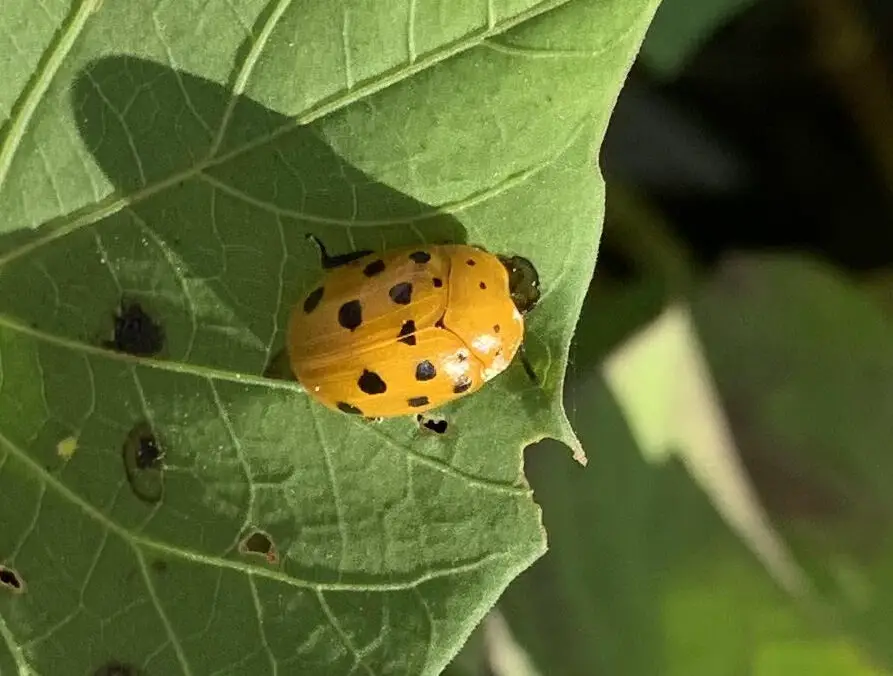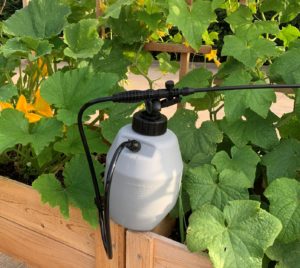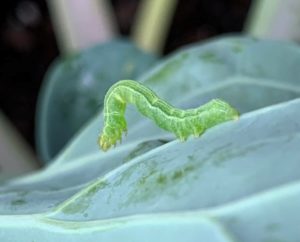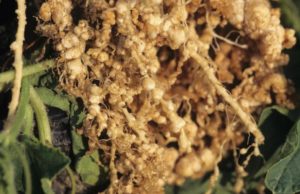The squash beetle or squash lady beetle (Epilachna borealis) is a member of the ladybug (ladybird) family and is most often found in the eastern part of the US. They measure approximately 7 to 10 mm (0.27 to 0.39 inches) and have a bright yellow to orange domed body with black spots. But don’t let this ladybug-look-a-like fool you. Unlike the smaller, beneficial ladybug, this beetle will wreak havoc in your garden. It prefers squash, zucchini, acorn squash, butternut squash, cucumbers, pumpkins, watermelon, and other cucurbits, but will also eat other plants such as beans, peas, and sweet potatoes.
Although the beetles hide on the underside of leaves (they may emerge on overcast days), they leave telltale signs of their presence. Both adults and larvae will cut a trench around an area of leaf before they eat it. The trench will be either in a semi-circle pattern at the leaf’s edge or a circular pattern towards the middle of the leaf. Scientists believe this is done to minimize the excretion of sap or chemicals the plant releases, perhaps to deter feeding. After cutting the trench, the larvae will then feast on the leaf tissue from the underside, while the adults will skeletonize the leaf by eating the upper and lower tissue, leaving only the leaf vein.
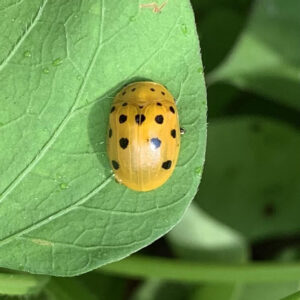
Later in the season, adult beetles will feed on the skin or rind of vegetables, leaving a spiral-shaped track. This can be problematic for those who wish to sell their produce.
How to Differentiate From Similar Beetles
The squash beetle is often confused with another destructive garden pest, the Mexican bean beetle. Although similar in appearance, they differ in several ways. For example, the squash beetle is about twice the size of the Mexican beetle and the traditional ladybug. The squash beetle can vary in color from yellow to orange, while the Mexican beetle has more of a copper color. What’s more, the squash beetle has a total of seven dark spots or partial spots on each wing covering (elytron) and four smaller spots on its upper thorax (pronotum: the first of its exoskeletal plates) or what is often wrongly identified as its head. The Mexican beetle, on the other hand, has a total of eight spots on each wing covering and no markings on its pronotum. And finally, the Mexican beetle prefers legumes over squash or other cucurbits.
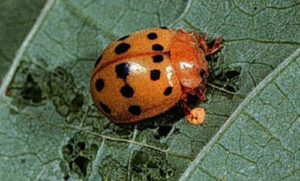
Squash beetles may also be confused with spotted cucumber beetles because they are both yellow with black spots and feed on cucurbits. They are easy to differentiate from one another, however, because the cucumber beetle’s body is more elongated and not round or dome shaped like the squash beetle’s. You can learn more about cucumber beetles in this helpful article.
Another insect that may be confused with the squash beetle is the squash bug. Both can be found on squash, cucumbers, melons, and other cucurbits, but they look entirely different. You can learn more about squash bugs, including how to identify them, in this informative article.
Life Cycle
The female squash beetle lays her eggs in July, most often on the underside of leaves. The yellow, oblong eggs are laid in a cluster of a few dozen or more.
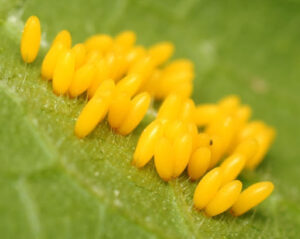
The larvae are yellow with six rows of black spines or spikes. They differ slightly from Mexican beetle larvae, which are also yellow, but whose spike tips darken as they mature.
Squash beetles go through four instars (stages) in a period of about three or four weeks. They pupate on the underside of leaves. Sometime in August, they will emerge as adults and feed for about two weeks before they begin to look for a place to overwinter. By the following June, the adults will seek out cucurbit crops to feed on and thus, repeat the cycle.
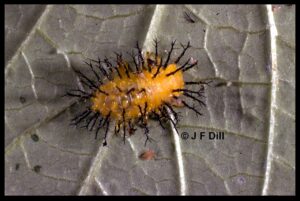
This article contains affiliate links. If you make a purchase using one of these links, I will receive a very small commission at no additional cost to you, and it will help me maintain this website. Rest assured, I only recommend products I actually like!
How to Treat Squash Beetles Organically
Like managing other garden pests, the key to dealing with squash beetles is early detection. Here are several tips to prevent or treat them organically.
Hand pick – A daily visit to the garden to inspect plants, especially the underside of cucurbits, can go a long way towards finding and removing beetles, eggs, and larvae by hand. Drop them in a jar of soapy water and dispose of them later.
Remove Plant Debris – Squash beetles overwinter in plant debris, so it is important to clean your garden.
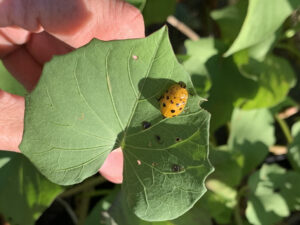
Plant Flowers that Repel – Nasturtiums and petunias are said to repel beetles. Plant them adjacent to your cucurbits to help protect them from squash beetles and other pests.
Organic Insecticides – Neem oil and insecticidal soap are effective against chewing insects like the squash beetle and larvae. To make your own organic insecticidal soap, mix 1 to 2 teaspoons of a Castile soap like Dr. Bonner’s in one quart of water (or 1 tablespoon in one gallon of water). Do a test spray on one leaf and wait 24 to 48 hours to see how the plant responds. If it shows signs of damage, dilute the mixture and perform another test spray. Spray the entire plant, including the underside of leaves, in the cool of the evening or early in the morning. Otherwise, the combination of the spray and sunlight could burn the plant. Repeat every 7 days.
To make your own neem oil spray, add 1 teaspoon of neem oil that contains Azadirachtin, the naturally occurring compound that makes the oil more effective. (Some premade sprays are made with neem oil that does not contain this important ingredient.) Add 1/2 teaspoon of Castile soap like Dr. Bonner’s, to 1 quart of water. Mix well. Do a test spray on one leaf and wait 24 to 48 hours to make sure the mixture is not too strong. If the leaf is damaged, decrease the amount of neem oil. If there is no damage, spray the plant, making sure to cover both sides of the leaves. Do not apply during the day as the combination of sun and neem oil can burn the plant. Instead, apply during the cool early morning hours or in the early evening. Repeat every 7 days.
When broader applications of either the organic insecticidal soap or the neem oil spray are necessary, I use a pump spray bottle like this one.
Row Cover – If you have a history of squash beetles every year (or other flying pest like the squash vine borer), you can place a row cover over the seedlings. You will need to remove the cover when the plants begin to flower so the pollinators can reach them. Or, you can remove the row cover long enough to hand pollinate and then recover the plants.
Squash beetles are beautiful, but they can destructive! Take the necessary steps to ensure they don’t wreak havoc on your crops.
Thank you for reading this article! If you found it helpful, please consider sharing it with others via email and social media!
